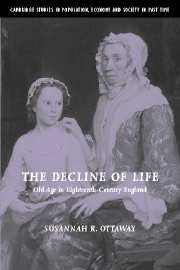Book contents
- Frontmatter
- Contents
- List of figures
- List of tables
- Acknowledgments
- List of abbreviations
- Introduction: Old age in eighteenth-century England: no “golden age of aging”
- 1 Who was “old” in eighteenth-century England?
- 2 The activities of the “helmsman”: self-reliance, work, and community expectations of the elderly
- 3 “The comforts of a private fire-side”
- 4 Independent but not alone: family ties for the elderly
- 5 Community assistance to the aged under the Old Poor Law
- 6 Continuity and change in community assistance to the elderly over the eighteenth century
- 7 Within workhouse walls: indoor relief for the elderly
- Conclusion: Old age as a useful category of historical analysis
- Bibliography
- Index
Introduction: Old age in eighteenth-century England: no “golden age of aging”
Published online by Cambridge University Press: 15 December 2009
- Frontmatter
- Contents
- List of figures
- List of tables
- Acknowledgments
- List of abbreviations
- Introduction: Old age in eighteenth-century England: no “golden age of aging”
- 1 Who was “old” in eighteenth-century England?
- 2 The activities of the “helmsman”: self-reliance, work, and community expectations of the elderly
- 3 “The comforts of a private fire-side”
- 4 Independent but not alone: family ties for the elderly
- 5 Community assistance to the aged under the Old Poor Law
- 6 Continuity and change in community assistance to the elderly over the eighteenth century
- 7 Within workhouse walls: indoor relief for the elderly
- Conclusion: Old age as a useful category of historical analysis
- Bibliography
- Index
Summary
The history of old age has often been characterized by the search for an elusive “golden age of aging.” In the past, so the story goes, families loved and cherished their old relatives; adult children nurtured their aging parents in their homes, and communities treated the venerable elderly with deep and abiding respect. The problem with this fairy-tale scenario is not only that there was no golden age of aging in the European past, but also that the sentimental model that it proposes, a model in which the aged are simultaneously dependent and revered, is both condescending and misguided. For, despite the continuing preoccupation of historians with the issues of family and community care for the aged, the goal of older people themselves in early modern Europe was to preserve their independence until their last days, and to remain full and contributing members of their families and societies for as long as their health allowed. This was certainly the case in the eighteenth century (a period which some historians actually have characterized as a golden age for the aged), when descriptions of old people, and the recorded words from the later lives of men and women, rich and poor, resonate with the shared cultural ideal of economic and residential autonomy.
At the same time, it is clear that cherishing independence in old age did not mean that individuals sought isolation or withdrawal.
- Type
- Chapter
- Information
- The Decline of LifeOld Age in Eighteenth-Century England, pp. 1 - 15Publisher: Cambridge University PressPrint publication year: 2004

